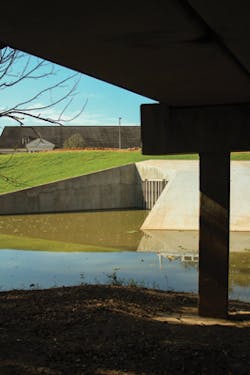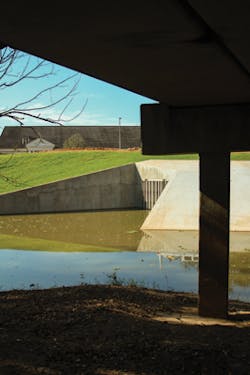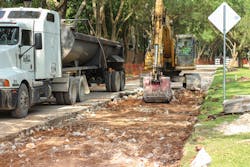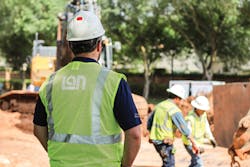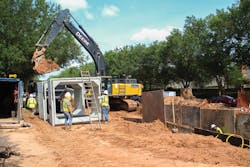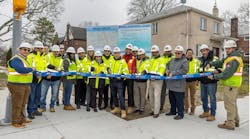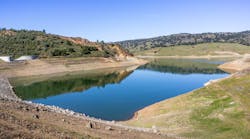By Matt Manges
Drainage improvements help Sugar Land community mitigate flooding issues during Hurricane Harvey
Sugar Land, Texas, is a city of 117,869 located 20 miles southwest of downtown Houston. Since 1990, Sugar Land has been among the state’s fastest growing cities. The community offers outstanding schools, libraries, civic organizations and other resources that make the city a great place to work, live and raise a family. Numerous high-profile regional and international corporations have chosen Sugar Land as a corporate home.
Sugar Land’s impressive growth is largely the result of a commitment to addressing the expectations of its citizens for quality city services. Remaining one of the nation’s safest cities has included significant investments in drainage infrastructure. With an almost entirely flat topography, the city has very little natural drainage and is hit every year by severe thunderstorms with extended rain periods over large areas. In 2015, during the Memorial Day flood event, most parts of the city received more than 10 inches of rainfall in eight to ten hours. The storm caused widespread street flooding in various parts of the city and several residents reported water damage inside their homes.
Recently, Sugar Land completed a $3.1 million drainage project along Lexington Boulevard to address flooding that occurred in 2015. Photo courtesy LAN.
Sugar Land’s five-year capital improvement program includes emphasis on drainage improvements, with funding allocated on a year-to-year basis. More than $43 million is planned over the next five years for drainage improvements to reduce street ponding that impacts emergency response and evacuation routes.
Recently, Sugar Land completed a $3.1 million drainage project along Lexington Boulevard to address a few homes that flooded in The Highlands in 2015 and past street flooding in The Highlands, Oyster Point, Sugar Wood and along Lexington Boulevard. In October 2015, the city contracted national planning, engineering and program management firm Lockwood, Andrews & Newnam Inc. (LAN) to study the drainage systems encompassing the subdivisions of Oyster Point, Sugar Wood Section II and Highland Section III. The city also asked LAN to design measures to improve the capacity of the overall drainage system.
2D Analysis
Multiple drainage systems with varying levels of conveyance capacities serve the Lexington Boulevard and Highlands Section III region. It encompasses 150 acres of drainage area, 5 miles of storm sewer and more than 130 inlets. This study area was evaluated using a two-dimensional InfoWorks ICM model at the individual inlet level to fully understand the region’s subsurface and overland sheet flow patterns and to identify stormwater infrastructure deficiencies. Two-dimensional models offer unique insight into how overland stormwater conveyance is tightly coupled to and influenced by the subsurface storm sewer system.
The project team installed several box culverts along Lexington Boulevard. Photo courtesy LAN.
The performance of the stormwater infrastructure within the study area was evaluated for the 100-, 25-, 10-, 5-, and 2-year, 24-hour design storm events and found to be functionally deficient in several locations throughout the region. The existing storm sewer system was inadequately sized with much of the region experiencing widespread roadway inundation during the 100-year, 24-hour events. Many of the roadways within the region were impassible during lesser events and subjected to excessively long time-to-drain durations. Additionally, the 2-year, 24-hour storm event produced ponding that exceeded the city’s design standards. The analysis determined that almost 65 percent of the existing storm sewer system had multiple deficiencies for both 100-year and 2-year storm events.
Drainage Solutions
Following the analysis, the project team recommended a series of drainage improvement projects in accordance with the city’s design standards and drainage master plan performance criteria. The goal was to meet as much of the current design criteria as possible while meeting the performance criteria. Retrofitting existing neighborhoods to meet current design criteria for extreme events can be a difficult process without substantial reconstruction of the entire neighborhood. For this reason, LAN designed plans that would greatly improve the drainage conditions and reduce flooding potential but not always meet 100-year design criteria in all areas outside of the Lexington Boulevard and Pecan Point Drive corridor.
The team aimed to install as much of the storm sewer system as quickly as possible before any big summer rain events. Photo courtesy LAN.
Two types of drainage improvements are usually considered when attempting to improve drainage within a region: stormwater conveyance and detention improvements. For the Lexington Boulevard area, the project team implemented conveyance improvements to move stormwater out of neighborhoods and downstream to Upper Oyster Creek. Improvements included upsizing parts of the Lexington Boulevard storm sewer trunkline, as well as those in Pecan Point Drive, Fort Settlement Drive, Colonist Park Drive, and Deer Creek Drive. Storm sewer pipes were added along Vinces Bridge to The Highlands Drive. New or extended inlets along Lexington Boulevard were designed at critical locations to capture overland sheet flows and reduce street ponding depths. Furthermore, the project team diverted a large portion of drainage runoff in this watershed to a new outfall at the downstream side of the Upper Oyster Creek Bridge to improve the capacity of the overall drainage system.
An analysis of the proposed improvements showed that ponding extents, depths, and durations reduced significantly and met the identified performance criteria. Total ponded area was reduced by 47 percent for the 100-year, 24-hour storm event and by 64 percent for the 2-year, 24-hour storm event. In addition, these improvements substantially reduced flooding durations. Inundated roadways with excessively long ponding durations also drained faster, according to the analysis.
The project called for the installation of 4,665 linear feet of storm sewer trunk line. Photo courtesy LAN.
Project Challenges
In May 2017, the city selected FUSED Industries as the contractor. In total, the contractor had to install 4,665 linear feet of storm sewer trunk line, which included 1,500 linear feet of 8’x7’ and 7’x6’ reinforced concrete box culverts, as well as nine new or extended inlets. Knowing that big rain events in the summer could overload the city’s existing system, the contractor’s team rushed to install the new storm sewer pipes.
“Typically, in drainage projects, most of the challenges are resident-related,” said Shad Cundiff, president of FUSED Industries. “But, in this instance, the residents of Sugar Land were eager for construction to begin as they had experienced flooding in the past. Our challenge was to install enough of the storm sewer system in a short period of time without impacting the existing system. We had to install several box culverts along Lexington Boulevard and a large diameter storm sewer at Fort Settlement and we had to do that as quickly as possible.”
In August 2017, three months after construction began, Hurricane Harvey pounded the region, dumping more than 40 inches of rain in several neighborhoods in the city. This created a new set of challenges.
“We weren’t able to access the site for more than a week,” said Cundiff. “After we could access the site, we were unable to get materials from suppliers. Once we got the hardscape materials, we couldn’t get aggregates, sands and backfills. It took us at least three weeks before we could start construction.”
Another challenge was to prevent backflow from Oyster Creek into the proposed outfall at the downstream side. To tackle this challenge during construction, the project team designed and installed a temporary flap valve. Subsequently, for the long term, an 8’x7’ flap gate was installed as a permanent solution.
The project team implemented conveyance improvements to move stormwater out of neighborhoods and downstream to Upper Oyster Creek. Photo courtesy LAN.
Results
The project’s benefits became immediately apparent during Hurricane Harvey, the most extreme rain event in U.S. history. Even though the project was only about 50 percent complete at the time the hurricane hit the region, it prevented streets and homes from flooding.
One year post-Harvey, city staff continue to focus resources on drainage improvements within Sugar Land. Engineers continue to improve the city’s drainage systems, evaluate drainage design standards, and work with Levee Improvement Districts on levee infrastructure intended to protect residents from extreme rainstorms.
Sugar Land received approximately 70 percent of its annual rainfall during Hurricane Harvey. Even so, less than one percent of Sugar Land homes experienced structure flooding. Drainage improvements implemented in areas like Lexington/Highlands just prior to the storm protected residents from the historic amounts of rain.
One of the residents commented, “In the Memorial Day and Tax Day flood, our house made it through [with] about one-inch of water coming in our front door. So, we know the Lexington project helped us because we had 38 inches of rain during Harvey over the five-day period, which, to us, meant we would have flooded otherwise. Several of our neighbors feel the same way. So, thank you for doing this project. We have already been the recipients of the work you are doing and we are grateful.”
In January 2018, the contractor completed the $3.1 million project — two months ahead of schedule. The project is an excellent example of how flood risks can be cost-effectively reduced while planning for future growth and development at the same time.
About the Author: Matt Manges, P.E., is a team leader and regional stormwater manager at Lockwood, Andrews & Newnam Inc., a national civil engineering firm. He can be reached at [email protected].
Circle No. 246 on Reader Service Card
